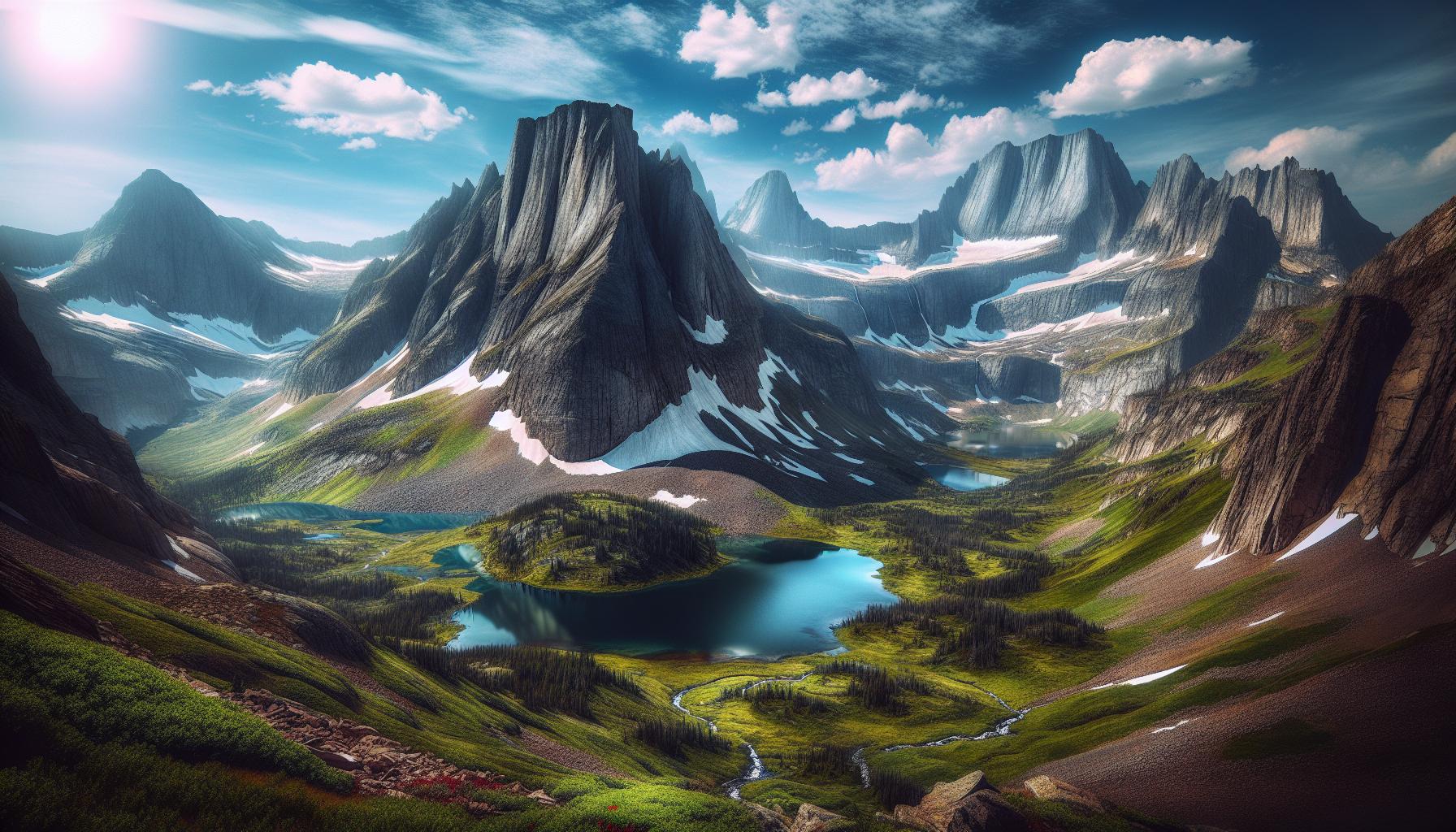There’s something magical about mountains that captures my heart every time I see them. Their towering peaks and breathtaking vistas evoke a sense of wonder and adventure that few other landscapes can match. Whether it’s the snow-capped summits or the lush valleys below, mountains offer a stunning backdrop that invites exploration and introspection.
As I delve into the beauty of these majestic formations, I can’t help but reflect on the unique experiences they provide. From hiking trails that wind through wildflower meadows to serene lakes that mirror the sky, mountains hold a treasure trove of natural wonders waiting to be discovered. Join me as I explore the enchanting world of Beautiful:fc9bdwd6wsq= Mountains and uncover the secrets they hold.
Key Takeaways
- Magical Landscape: Mountains evoke a sense of wonder and adventure, offering breathtaking vistas and unique experiences that inspire exploration.
- Diverse Ecosystems: Home to varied climates and wildlife, mountains feature endemic species, creating rich ecosystems that are crucial for biodiversity.
- Recreational Opportunities: Activities such as hiking, climbing, and skiing allow individuals to connect with nature while enjoying the stunning surroundings of mountainous regions.
- Cultural Importance: Mountains are vital to local communities and cultures, often viewed as sacred spaces that shape traditions and livelihoods.
- Conservation Efforts: Initiatives to preserve mountain environments are essential for maintaining their beauty and ecological health for future generations.
- Distinct Geography: Major mountain ranges, like the Himalayas and Rockies, exhibit unique geographical features that contribute to their grandeur and charm.
Beautiful:fc9bdwd6wsq= Mountains
Beautiful:fc9bdwd6wsq= Mountains captivate me with their grandeur and diversity. Peaks soar high, often draped in a blanket of snow or adorned with vibrant greenery. These majestic formations host varied ecosystems that attract adventurers and nature lovers alike.
Mountains provide unique recreational opportunities. Activities such as hiking, climbing, and skiing draw individuals seeking both thrills and tranquility. Many trails offer access to breathtaking views and serene landscapes that inspire awe.
Diverse geography defines the beauty of mountains. From the granite faces of the Sierra Nevada to the rolling hills of the Appalachian range, each mountain range offers distinct character and charm. Notably, certain regions blend rich history and cultural significance with natural beauty.
The wildlife inhabiting mountainous areas enhances their allure. Species such as mountain goats, bears, and colorful birds thrive in these environments, creating dynamic ecosystems. Each interaction with these creatures adds to the experience of exploring mountainous terrains.
Efforts to preserve these natural wonders play a crucial role in maintaining their beauty. Conservation initiatives protect ecosystems, promote sustainable tourism, and encourage responsible exploration, ensuring future generations can appreciate these breathtaking landscapes.
Geography and Location

Mountains possess distinct geographical features that shape their locations and ecosystems. Exploring major mountain ranges and unique landscape attributes reveals their grandeur.
Major Mountain Ranges
The world’s mountains fall into several prominent ranges.
- Himalayas: Home to Mount Everest, the highest peak globally, the Himalayas span five countries: Bhutan, India, Nepal, China, and Pakistan.
- Andes: Stretching along South America’s western edge, the Andes encompass diverse ecosystems and host significant peaks like Aconcagua, the highest in the Americas.
- Rocky Mountains: Extending over 3,000 miles across North America, the Rockies are known for their rugged terrain and vibrant wildlife.
- Alps: Found in Europe, the Alps are famed for their iconic peaks, including Mont Blanc, and serve as a hub for winter sports enthusiasts.
- Appalachians: Running through the eastern United States, the Appalachian Mountains offer rolling hills and rich biodiversity since their formation over 480 million years ago.
Unique Landscape Features
Mountains showcase unique geographical features that enhance their beauty.
- Glacial Valleys: Carved by ancient glaciers, these U-shaped valleys create dramatic scenery and fertile grounds for wildlife.
- Rock Formations: Distinct formations such as spires, cliffs, and mesas provide stunning visual elements and challenge climbers.
- Lakes and Glaciers: High-altitude lakes and glaciers serve as essential water sources while creating breathtaking panoramas.
- Flora and Fauna: Varied ecosystems from alpine tundra to temperate forests support rich biodiversity that captivates nature observers.
These geographical and locational characteristics contribute to the allure and complexity of mountain environments.
Flora and Fauna

Mountains support diverse ecosystems filled with unique flora and fauna. Their varying climates and altitudes create environments where specialized species thrive.
Endemic Species
Mountains host numerous endemic species, which occur nowhere else on Earth. Unique plants, like the Alpine edelweiss and the Rhododendron, bloom in alpine meadows, adapting to high altitudes and extreme conditions. Mountain goats, adapted for rocky terrains, navigate steep cliffs with great agility. Rare birds, such as the Himalayan monal, display vibrant plumage, attracting enthusiasts and researchers alike. These endemic species contribute to the ecological richness and biological diversity of each mountain range.
Conservation Efforts
Conservation efforts focus on protecting these delicate ecosystems from threats like climate change and habitat destruction. Organizations engage in reforestation initiatives to restore native species and improved land management practices to minimize human impact. Programs for sustainable tourism promote responsible exploration, ensuring that visitors enjoy the natural beauty without harming it. Increased awareness and education regarding mountain ecosystems foster community involvement in preservation, further securing the mountains and their unique flora and fauna for future generations.
Activities and Attractions

Mountains offer a range of activities and attractions that appeal to adventurers and nature enthusiasts alike. These experiences allow me to immerse myself in the stunning landscapes while enjoying the diverse recreational opportunities available.
Hiking Trails
Hiking trails provide access to the mountains’ breathtaking views and unique ecosystems. Popular trails, such as the John Muir Trail in the Sierra Nevada and the Appalachian Trail on the East Coast, showcase incredible scenery and varying difficulty levels. Trail lengths can range from short, leisurely walks of a few miles to challenging multi-day hikes spanning over 200 miles. Major trailheads often feature amenities like maps, rest areas, and information about local flora and fauna, enhancing the overall hiking experience.
Scenic Viewpoints
Scenic viewpoints allow me to appreciate the breathtaking panoramas mountains offer. Iconic spots like Glacier Point in Yosemite National Park and the lookout at Banff National Park provide optimal conditions for photography and relaxation. Some viewpoints are accessible by car, while others require a short hike. Many viewpoints are equipped with benches and informational plaques, which detail the surrounding geography, wildlife, and conservation efforts. These locations serve as perfect places to pause, reflect, and enjoy the majestic beauty of the mountains.
Cultural Significance
Mountains hold profound cultural significance for local communities and throughout history. Their presence influences traditions, art, beliefs, and practices across various cultures.
Local Communities
Mountains are central to the identity of many local communities. They provide resources like water and materials that support livelihoods. Indigenous populations often view mountains as sacred spaces, integral to their spiritual beliefs and cultural practices. For example, the Andes Mountains are considered the “Apu,” or mountain spirits, by Andean cultures. Community events, including festivals and rituals, typically celebrate the seasonal changes that the mountains signify, reinforcing the bond between the people and their environment.
Historical Context
Historically, mountains served as natural barriers and gateways that shaped human movement and settlement patterns. Ancient trade routes frequently traversed mountain ranges, facilitating commerce and cultural exchange. The Silk Road, for example, moved goods through mountainous terrains, linking Eastern and Western cultures. Additionally, mountains often provided refuge during conflicts, influencing the development of numerous civilizations. Their storied pasts enhance the allure and understanding of these majestic environments.
The Beauty of Majestics Formations
Mountains truly hold a special place in my heart. Their breathtaking beauty and diverse ecosystems never cease to amaze me. Each visit offers a new adventure and a chance to connect with nature in profound ways.
I cherish the moments spent hiking through wildflower meadows or standing in awe at a serene lake surrounded by towering peaks. The cultural significance and historical richness of these landscapes deepen my appreciation even further.
As I explore these majestic giants, I’m reminded of the importance of preserving their delicate ecosystems for future generations. I believe that by embracing sustainable tourism and responsible exploration, we can ensure that the beauty of mountains continues to inspire wonder and adventure for years to come.

